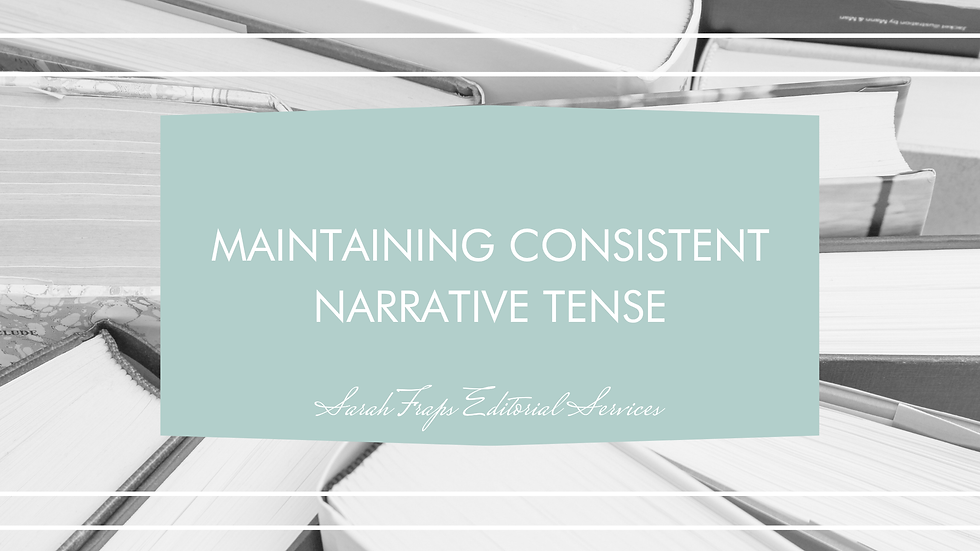Dialogue tags & action beats
- Sarah Fraps

- Nov 17, 2023
- 4 min read
Updated: Dec 20, 2023
Formatting attributes of speech alongside action in fiction

I've written about the basics of formatting dialogue here. This blog is a deeper dive into industry standards and expectations for formatting dialogue tags and action beats in a variety of scenarios in fiction.
The basics
Here are some basic definitions to get us started. First, a dialogue tag is simply an attribution. It tells the reader who is speaking and usually consists of a pronoun and a verb:
He/she/they/I + say/said or ask/asked
There isn't much purpose for the dialogue tag beyond helping the reader keep track of who is speaking. A dialogue tag is not always required, and its placement in relationship to the discourse (before or after or not at all) is often left up to the consideration of the author. Placement and inclusion can sometimes be used to affect the cadence or balance of a sentence.
An action beat, on the other hand, is a description that tells the reader what the speaker is doing during the course of a stretch of dialogue. Both dialogue tags and action beats contain verbs, and it can be difficult, at times, to know what types of verbs are acceptable and which are not.
Thankfully, there are some generally accepted "standards" to help discerning writers.
A case for said/say and ask/asked
I once heard an author describe the use of verbs other than said and asked in dialogue tags like sprinkling salt on food. A little is good and enhances the flavor of the dish (or the writing, in this case), but too much, and it can completely spoil the meal.
In general, I think most writers and authors agree that it is standard and good practice to make say and ask the primary dialogue tags in writing. Occasionally, I'll see someone argue that using only those tags is potentially boring.
However, from an editorial perspective, say and ask have essential superpowers—they are virtually invisible. And from a line or copyeditor's perspective, the invisibility of these words allows for a smooth reading experience where the reader isn't distracted by odd or nonsensical word choice (which is, ultimately, the goal of good editing!).
After all, the author should want the reader to focus on what's being said and who is saying it in the course of dialogue, not necessarily how it is being said (that's the job of descriptive action).
Verbs that work for action but not dialogue
This brings us back to action and its relationship to dialogue. Where I see a desire to use verbs other than say/ask as dialogue tags, there is often an imbalance of showing and telling. For instance, it could be that in an effort to add description of facial features and action to the discourse, an author uses verbs as dialogue tags that cannot possibly be done while speaking.
"What did you do at school today?" he smiled.
"Smile" tells the reader something about what the speaker looks like and what he is doing, but smiling is not a mechanism for speech. Imagine trying to grin while speaking—it doesn't quite work. Similarly, words like grunt, groan, moan, spit, hiss, cry, sob, jeer, sneer, breathe, etc. are all verbs that describe actions, not how words are said. (And this is just a taste of a few of them!)
"I'll miss you," she breathed.
He groaned, "How could you?"
"I didn't get any cake!" she sobbed.
"You disgust me," she spat.
Some verbs used incorrectly as dialogue tags lean heavily on telling (though the author may think they are showing by using them). And some are simply redundant. Take sass, rage, and interrupt below.
"You can't get me!" she sassed.
"You'll regret that!" he raged angrily.
"I'm going—" "Oh, can I go too?" she interrupted.
Other verbs that simply don't work: counter, argue, reprimand, refute, add, etc.
Connecting dialogue and action
There are several ways writers can connect action to dialogue. Let's take the action "smile" from above as the simplest example. (Note, in the first example, "he" is now capitalized to show that "He smiled" is separate from the dialogue and not acting as a dialogue tag.)
"What did you do at school today?" He smiled.
"Let's go to the park." He smiled.
"Let's go to the park," he said, smiling.
"Let's go to the park," he said with a smile.
"Let's go to the park," he said and smiled.
Smiling, he said, "Let's go to the park."
He smiled and said, "Let's go to the park."
With a smile he said, "Let's go to the park."
He smiled. "Let's go to the park."
An action might also interrupt the dialogue. In Chicago Style, and in fiction in the US in general, an em dash (not commas or en dashes) sets action apart when it interrupts speech.
"Today was"—he took a deep breath—"exhausting."
Used at the beginning or end of the dialogue, this action is its own sentence and should be formatted as in the examples above. It might help to remember that the action beat and the verb used in the dialogue tag are two distinct or separate actions—the action that does and the action that says.
He took a deep breath. "Today was exhausting."
He took a deep breath and said, "Today was exhausting."
There is no need to connect the action beat to the dialogue in any way (a comma or otherwise) even if the character taking the action is the same character who is speaking. Placing the action and the dialogue on the same line (along with other clues) will signal to the reader who is doing and saying what.
This is just the tip of the iceberg for this topic. Are there any tag or beat scenarios you've come across in your own writing that you're wondering about? Let me know, and I'll likely write a follow-up blog!








Comments